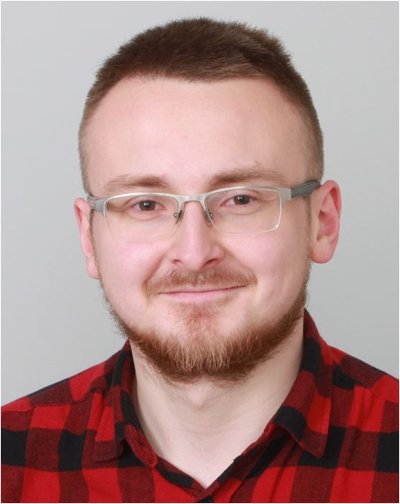Theoretical and computational analysis of wave confinement in periodic media
Marek Kozon is a PhD student in the department Mathematics of Computational Science. (Co)Supervisors are prof.dr.ir. J.J.W. van der Vegt and dr. M. Schlottbom from the faculty of Electrical Engineering, Mathematics and Computer Science and prof.dr. W.L. Vos from the faculty of Science and Technology.
 Crystals are an important type of natural or man-made materials that can be utilized for manipulation of various physical waves by their interference in the periodic structure. Waves can thus be reflected, directed, confined, or forced to interact in a specific way. The wave behavior in crystals is, however, notoriously complicated and many questions on this topic still remain unanswered. In this PhD thesis, we developed theoretical and numerical methods for the analysis of wave propagation through crystals and their confinement, allowing us to better understand these phenomena. Although our results are illustrated on and applied to mostly 3D inverse woodpile photonic crystals, many of them are directly applicable to general crystals interacting with any type of physical waves. The basic concepts used in this PhD thesis are introduced in Chapter 1.
Crystals are an important type of natural or man-made materials that can be utilized for manipulation of various physical waves by their interference in the periodic structure. Waves can thus be reflected, directed, confined, or forced to interact in a specific way. The wave behavior in crystals is, however, notoriously complicated and many questions on this topic still remain unanswered. In this PhD thesis, we developed theoretical and numerical methods for the analysis of wave propagation through crystals and their confinement, allowing us to better understand these phenomena. Although our results are illustrated on and applied to mostly 3D inverse woodpile photonic crystals, many of them are directly applicable to general crystals interacting with any type of physical waves. The basic concepts used in this PhD thesis are introduced in Chapter 1.
Chapter 2 introduces a general scaling theory of identification and classification of wave confinement in crystal superlattices. Starting from the confinement energy and the mode volume, we use finite-size scaling to find that ratios of these quantities raised to certain powers yield the confinement dimensionality of each band. Our classification has negligible additional computational costs compared to a band structure calculation and is valid for any type of wave, both quantum and classical, and in any dimension. In the quantum regime, we illustrate our method on electronic confinement in 2D hexagonal boron nitride with a nitrogen vacancy, in agreement with previous results. In the classical case, we study a three-dimensional inverse woodpile photonic band gap cavity superlattice, where we identify novel acceptor-like behavior.
In Chapter 3, we investigate the possibility of improving the accuracy of our scaling method for classification of wave confinement in very small supercells by means of machine learning. This is often the case for 3D photonic crystals, since light propagation through these structures is notoriously difficult to calculate and one is restricted to very small supercells in the computations. Moreover, small supercells are also often used in the experiments, making them an extremely important case to investigate. Unfortunately, due to the nature of scaling theories in general, small supercells are also those where the results of our scaling method are the least accurate. We therefore slightly reformulate the scaling theory of Chapter 2 and use it to implement two different clustering algorithms to classify wave confinement in photonic crystals. We compare the performance of the clustering algorithms with the results obtained by direct application of the scaling theory. We find that, under some circumstances, the clustering algorithms outperform the direct application of the scaling theory, but their applicability is limited. Therefore, we conclude that the use of clustering algorithms does not supersede the direct scaling theory, but that they can be used as auxiliary tools to enhance the precision of the results for small supercells.
In Chapter 4, we employ the results of the previous chapters to analyze the light-confining properties of inverse woodpile photonic superlattices with respect to their structural parameters, namely the regular and defect pore radii. We create so-called confinement maps, depicting the dependence of the number and energy concentration of 3D confined bands on the crystal structural parameters. We find that certain minimal deviations between the two pore sizes are required for the appearance of 3D confined bands and larger deviations favor higher number of confined bands. Further, we investigate symmetries of selected bands and discuss their relation to electronic orbitals, suggesting that photonic structures offer greater variety of state geometries and symmetries than electronic systems, which can also be relatively easily controlled. Finally, we analyze the suitability of various inverse woodpile structures for cavity quantum electrodynamics applications. We find that the donorlike crystals with smaller defect pores than regular pores are more favorable for such applications as a result of their larger silicon volume around the cavities.
In Chapter 5 we investigate the problem of light propagation through realistically large photonic crystals - a notoriously computationally difficult task. To this end, we develop a size-robust discontinuous Galerkin finite element method, where we approximate the solution of a large but finite crystal by a set of Bloch modes, representing the solutions of an infinite crystal. We describe the construction in detail and numerically analyze the convergence and performance of our method.
We conclude in Chapter 6 by summarizing the results of this PhD thesis and providing suggestions for future research.





